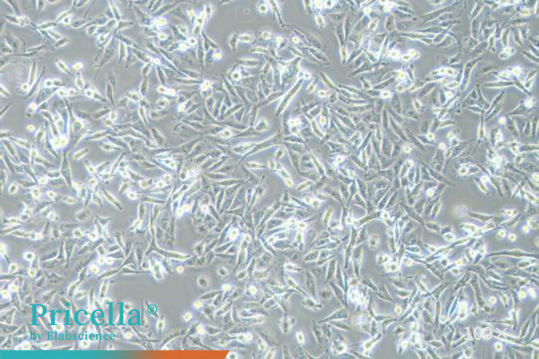Unveiling the Key Points of MDA-MB-231 Culture: Making Breast Cancer Research Easier
Oct 21,2025
MDA-MB-231 are a classic model of triple-negative breast cancer (TNBC), belonging to the claudin-low molecular subtype. They lack expression of estrogen receptor (ER), progesterone receptor (PR), and HER2, making them a valuable tool for TNBC research. These cells also display epithelial-mesenchymal transition (EMT) traits, the CD44+/CD24- cancer stem cell phenotype, and carry key mutations such as TP53-R280K and KRAS-G13D.
Highly invasive and metastatic, MDA-MB-231 are widely used to develop animal xenograft tumor models, explore the mechanisms of breast cancer invasion and metastasis, and screen targeted therapies.
In this issue of Cell Culture Academy, we provide a detailed introduction to MDA-MB-231 and practical tips for their culture, helping you conduct experiments more efficiently.
I.Basic Information
Species origin: Human
Tissue origin: Breast adenocarcinoma, metastatic pleural effusion
Tumorigenic property: Capable of forming poorly differentiated adenocarcinoma (Grade Ⅲ) in nude mice and BALB/c mice treated with ALS (anti-lymphocyte serum)
Growth characteristics: Adherent cells
Cell morphology: Epithelial-like cells
Freezing conditions: Freezing medium (55% basal medium + 40% fetal bovine serum + 5% DMSO)
Freezing temperature: Liquid nitrogen
II.Overview of Cell Culture
1. Growth Characteristics
MDA-MB-231 grow at a relatively slow pace. Generally, they are subcultured at a ratio of 1:2-1:4, and it takes 4-6 d for them to be ready for the next subculture.
During the culture process, it is normal to observe a small number of floating, round cells with black particles on their surfaces, which require no special treatment.
These cells are not difficult to culture per se, but they require a certain amount of patience. Frequent removal of the cells for observation should be avoided, as temperature fluctuations can affect their state.
2.Medium Selection and System Analysis
Depending on the experimental conditions, the following two culture schemes can be selected:
Scheme 1: Original Culture System
| Culture System | Culture Conditions | Others |
| Leibovitz's L - 15 + 10% fetal bovine serum + 1% penicillin-streptomycin solution |
Gas phase: 100% air Temperature: 37℃ No CO₂ incubator required |
Recommended subculture ratio: 1:2-1:4 Recommended medium change frequency: 2-3 times per week |
Scheme 2: Conventional Alternative System
| Culture System | Culture Conditions | Others |
| DMEM + 10% fetal bovine serum + 1% penicillin-streptomycin solution |
Gas phase: 95% air, 5% CO₂ Temperature: 37℃ Suitable for a CO₂ incubator |
Recommended subculture ratio: 1:2-1:4 Recommended medium change frequency: 2-3 times per week |
3.Characteristics of Culture Media
A.Leibovitz's L-15 Medium
The buffer system of Leibovitz's L-15 medium mainly relies on the secondary dissociation reaction of phosphate (H2PO4- ⇌ H+ + HPO4²-), in which KH2PO4 and Na2HPO4 are the core components. It can maintain a stable pH without exogenous CO2.
If Leibovitz's L-15 medium is used in a conventional CO2 incubator, the high concentration of CO2 dissolved in the medium will cause acidification, leading to a decrease in pH. The medium will turn yellow (using phenol red as an indicator), which is toxic to cells.
In addition to phosphate, Leibovitz's L-15 medium also contains a high concentration of amino acids, especially glycine and histidine, which have strong buffering capacity and can provide a certain degree of pH stabilization.
To simplify the operation, Pricella® has launched MDA-MB-231 Cell Complete Medium (L15), which has already been supplemented with serum and dual antibiotics. It can be used immediately after opening, making it more convenient.
B.DMEM Medium
DMEM relies on the NaHCO3 buffer system: The acidic substances produced by cell metabolism react with NaHCO3 in the medium to release CO2 (CO2 + H2O ⇌ H2CO3 ⇌ H+ + HCO3-), thus maintaining relative pH stability. This system requires a certain concentration of CO2 to achieve balance.
DMEM must be used in a 5% CO2 incubator, which is compatible with most conventional laboratory culture equipment.
Pricella® has launched MDA-MB-231 Cell Complete Medium (DMEM), which has already been supplemented with serum and dual antibiotics and can be used directly after opening.
III.Cell Culture Cases
MDA-MB-231 were cultured in Leibovitz's L-15 and DMEM medium, respectively. The cells were generally consistent in terms of morphology, characteristics, subculture timing, and ratios (Figure 1). Therefore, a suitable system can be flexibly selected according to the laboratory's culture conditions.


Figure 1. MDA-MB-231 cultured in different media (Left: Leibovitz's L-15; Right: DMEM)
Prev: Causes and Solutions for Morphological Alterations in Cells
Next: Unlocking the Hidden Potential of Mesenchymal Stem Cells: From Characterization to In Vitro Culture


